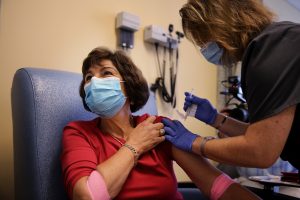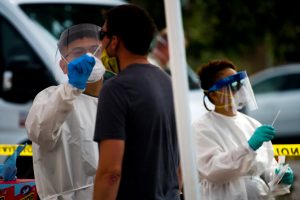A handful of California counties are expected Tuesday to regress to more restrictive tiers in the state’s coronavirus reopening system amid an increasingly worrying surge in infections, officials said.
Though an official announcement won’t come until later in the day, Gov. Gavin Newsom foreshadowed the changes, saying he anticipates “we will see more restrictive tiering based upon case rates that have begun to increase.”
“This is exactly why we designed the tier status the way we did,” he said during a briefing Monday. “It was about being more and less restrictive — not based upon political whim, but based upon the data, based upon the epidemiology, based upon the facts on the ground and, again, based upon local conditions in the 58 counties throughout the state of California.”
The state’s reopening roadmap, which determines the extent to which businesses, schools and other public spaces can operate, is broken into four color-coded tiers: purple, the strictest, followed by red, orange and yellow.
As of the last tier update, 10 counties were in the purple tier — including Los Angeles, Riverside and San Bernardino — and there were 20 in red, 19 in orange and nine in yellow.
Counties are placed into tiers based on two primary metrics: the average daily number of new coronavirus cases for every 100,000 residents and the percentage of conducted tests that detect the virus.
Though Newsom didn’t specify which counties could regress, he suggested “places like Mono County, you look at Kings, Alpine, Shasta counties … you’re starting to see case rates growing.”
As of Tuesday morning, those four counties had seen the the most new coronavirus cases per 100,000 residents in the last seven days, according to The Times’ coronavirus tracker. Among those, Shasta County has already regressed to the purple tier.
One county that’s known to be in danger of slipping is San Diego, which is currently in the red tier. Counties are at risk of backsliding if their metrics worsen for two straight weeks, and San Diego reached purple territory last week.
A second such score would require businesses and other organizations — including restaurants, movie theaters and houses of worship — to restrict access. Generally, moving to the purple tier forces many businesses and organizations to either reduce capacity or move their operations outdoors.
Orange County Executive Officer Frank Kim said his county is expected to remain in the red tier this week despite a rise in coronavirus cases, but it is at risk of falling back if the trend continues.
“We’re going to still be in the red tier tomorrow,” he said Monday. “The data for next Tuesday, though, shows we’re right on the edge. Unless something changes, we risk the purple tier.”
Just as they can regress, counties can also advance into less restrictive tiers if their numbers meet improved criteria for two consecutive weeks.
It’s possible no counties will move forward this week, according to California‘s health and human services secretary, Dr. Mark Ghaly.
While the reasons for increased coronavirus spread — and the type of behaviors and venues driving those trends — can vary from county to county, Ghaly said Monday that “almost each county that’s having increased transmission, they mention private household gatherings as a major source of spread.”
“It’s a place where we can make important inroads,” he said. “Our own choices can really reduce that transmission there and help not just transmission rates to come down, but our entire economy to stay moving.”
Health officials throughout the state have been emphasizing that mantra for months, saying that residents’ choices on gatherings, as well as the precautions they do or don’t take when doing so, will play a major role in shaping how the pandemic plays out.
California already finds itself at a new crossroads. Coronavirus cases are beginning to trend distressingly upward in the state and are skyrocketing in many parts of the nation.
The latest seven-day average for new cases statewide is 5,889, up from the 14-day average of 5,060.
The state is fast approaching 1 million total cases and, as of this week, had officially recorded more than 18,000 deaths.
Newsom said the increases in the state are “for obvious reasons: People are letting their guard down.”
“They’re taking their masks off; they’re starting to get together outside of their household cohorts; they’re starting to see businesses reopen; and we’re starting — again — to see more people mixing,” he said. “As it gets colder, we’ll see more still. So this was anticipated. No one is surprised by this.”
While a fall/winter wave was perhaps not unexpected, officials stressed that residents need to step up to keep it as mild as possible and continue to wear masks in public, wash their hands regularly, keep physical distance from those with whom they do not live and avoid gathering with others — or at least take precautions when doing so.
“We don’t have the luxury of ignoring our individual and collective responsibilities if we want to see more children go to school and businesses remain open,” said L.A. County Public Health Director Barbara Ferrer.
“Recovery just doesn’t continue when you have thousands of new cases each day. And many of these cases stem from people taking risks that are, frankly, not appropriate. It isn’t that hard to play by the rules, especially since these rules are what keep some people alive and allow our economy to improve.”
City News Service contributed to this report.


















